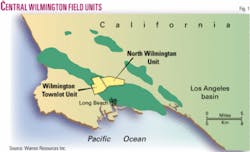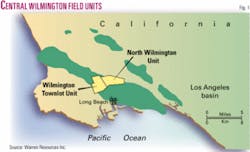Central Wilmington oil field due for denser development
The central part of supergiant Wilmington oil and gas field is in the midst of a redevelopment project in which more than 500 wells drilled in the next few years.
Los Angeles city authorities in late 2006 approved the drilling of as many as 540 directional oil and water injection wells from central facilities. The zoning approval facilitates plans by Warren Resources Inc., New York, to drill from two cellars under construction and due to be in operation by the end of the first quarter of 2007.
Warren Resources had booked 50 million bbl of net proved reserves in Wilmington at the end of 2005 and believes its two units in the central part of the field hold large oil recovery potential.
The Wilmington Townlot Unit, the company estimates, has produced only 20% of the estimated 727 million bbl of original oil in place, leaving an average remaining recovery potential of 228,000 bbl/well. The adjacent North Wilmington Unit has produced 24% of the estimated 165 million bbl of OOIP compared with 36% recovery for the field.
In fact, Warren Resources estimates that Townlot could yield another 92 million bbl of oil if the company were able to attain a 32% recovery factor.
Greater Wilmington field, the majority of which is operated by Occidental Petroleum Corp., had produced more than 1 billion bbl of oil and 900 bcf of gas through the late 1960s since discovery in 1932. Cumulative oil production has now surpassed 2.5 billion bbl. Part of the field underlies Long Beach harbor (OGJ, Aug. 15, 2005, p. 18). An Exxon Corp. predecessor unitized Townlot in 1973, and the former Sun Oil Co. unitized North Wilmington the same year.
Warren’s tenure
Warren Resources took over operation of Townlot in March 2005 and North Wilmington at the end of 2005.
The units are in the Los Angeles basin north of the city of Long Beach.
The company had hiked Townlot production to more than 2,000 b/d in late January 2007 from 375 b/d at acquisition and said it is beginning to see the effects of its waterflood in the Upper Terminal formation. North Wilmington, where the 2006 program was to return idle wells to production, makes close to 400 b/d.
The 2007 budget is $50 million at Townlot and $18 million at North Wilmington for drilling and infrastructure. That includes 34 producing and injection wells at Townlot and 14 new wells and 12 recompletions at North Wilmington.
The units produce oil mainly from the Upper Terminal at 4,000 ft and the shallower Ranger and Tar formations, all Tertiary in age. The deeper Ford zone has produced 4.1% of 70 million bbl of OOIP at Townlot.
The strategy at Townlot is to develop seven-spot waterflood patterns in the Ranger and Upper Terminal formations. Meanwhile, the first six Tar formation wells were averaging 125 b/d of oil with a water:oil ratio of 1 in late January 2007, albeit on limited production history. The former operator did not waterflood the Tar zone.
The company plans to construct as many as five doublewide drilling cellars at Townlot that can each accommodate two rows of wells in open cement-lined trenches. This permits production equipment to be located below ground level.
A skid-mounted drilling rig allows for rapid rig moves, and all fluid production and clean water reinjection occurs at wellheads in the cellars.

